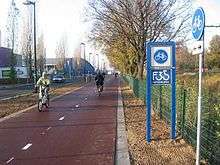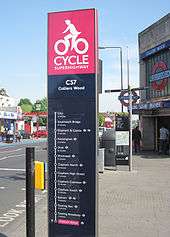Bike freeway
A bike freeway, also known as a cycling superhighway, fast cycle route or bicycle highway, is an informal name for a bicycle path that is meant for long-distance traffic. There is no official definition of a bicycle highway. The characteristics of a cycle motorway mentioned by authorities and traffic experts include an absence of single-level intersections with motorized traffic, a better road surface (preferably asphalt or concrete) and the absence of traffic lights. Bicycle highways are mentioned in connection with traffic jam. Owing to higher average speeds than normal cycling infrastructure, they provide an alternative to the car in commuter traffic. Often a cycle motorway follows the route of a railway.

Legal uses
In the Netherlands, the following people can use a bike freeway:
- Cyclists: 'ordinary' cyclists, recumbents, cargo bikes, velomobiles, pedelecs
- Riders of a motorized bicycle with a maximum speed of 25 km / hour
- Depending on the location also mopeds, with a maximum speed of 40 km / hour
- Pedestrians if pavement and footpath are missing
- Riders of a segway
- Drivers of a disabled vehicle. However, a maximum speed of 30 km / hour applies to them.
Features
Netherlands
In the Netherlands the bicycle highway is not defined in the RVV (Dutch: Reglement verkeersregels en verkeerstekens). However, there is a guideline for developing bicycle highways. The Dutch Ministry of Transport, Public Works and Water Management describes the bicycle highway as a long cycle path without crossings, on which cyclists can travel long distances. By building bicycle highways, the government hopes, among other things, to promote the use of bicycles for commuter traffic and thus prevent traffic jams.
Belgium
In Belgium this type of cycle path is not mentioned in the Road Code. In Belgium, especially the provincial governments and the Flemish Region take the initiative for the construction of bicycle highways. At the Flemish Regional level there are no guidelines on the design of cycle highways, only on 'normal' cycle paths. In practice, there are differences between the provinces. This is because the authorized Flemish departments (MOW, Department of Policy) and agencies (AWV) are organized per province, which results in different emphasis per region. They are called a bicycle highway because of the route signaling.
There is no maximum speed (for cyclists), unless indicated otherwise. The Flemish bicycle highways are numbered and indicated as such. All routes are indicated with a number starting with an F, going from F1 to F791 (The 'F' refers to 'Fiets' (Dutch for bike)).
Cost of construction
The cost of building a bicycle super highway depends on many things, but is usually between €300000/km (for a wide dedicated cycle track) and €800000/km (when complex civil engineering structures are needed).[1]
Lane width
In the Netherlands:
- The minimum desired width of the bicycle lane is 2.00 meters on the bicycle highway. The absolute minimum width of the bicycle lane is 1.50 meters.
In Belgium:
- Antwerp: double direction bicycle paths must be at least 3 meters wide
- Flemish Brabant: double-direction bicycle paths must be 4 meters wide (at least 3 meters), single-direction bicycle paths 2.5 meters (at least 2 meters)
- East Flanders: double-direction cycle paths must be at least 3 meters wide.
Bike freeways by country
Belgium (Flanders)
Within Flanders, a network of bike freeways, consisting of around 120 routes, is being rolled out, connecting all Flemish cities. All routes are indicated with a number starting with an F, going from F1 to F791.
The whole network will consist of 2400 km bike freeways, connecting all Flemish cities. As of 2018, around 1500 km is completed. Most Flemish cities are therefore already connected by bike freeways or a temporary alternative. It's therefore possible to travel around the whole Flemish region by bike from city to city with a nearly absence (or at least minimum) of single-level intersections with motorized traffic ("without a single stop").
Ghent is for example connected by bike freeways to almost all neighbouring Flemish cities (Bruges, Deinze, Kortrijk, Roeselare, Oudenaarde, Antwerp,...).
Many bike freeways are purpose-built bicycle superhighways with dedicated bicycle bridges and intersections or at least (two-way) bicycle paths. Many purpose-built bike freeways follow the route of the railway system. However, many existing towpaths along rivers and canals have also been integrated within this network of bike freeways as they often responded to the minimum requirements with only minor adaptations.
Netherlands
The first Dutch route opened in 2004 between Breda and Etten-Leur; many others have been added since then.[2] In 2017 several bicycle superhighways were opened in the Arnhem-Nijmegen region, with the RijnWaalpad as the best example of this new type of cycling infrastructure.
Denmark
In Denmark there exists a network of long-distance and high-speed cycle paths connecting the suburban areas of Copenhagen with the city core. There are eight routes in operation in September 2018. There are plans of building 45 routes with a total length of 476 km by 2021 in the cities and municipalities of the Capitol Region of Denmark.[3]
The first Danish route, C99, opened in 2012 between the Vesterbro rail station in Copenhagen and Albertslund, a western suburb. The route cost 13.4 million DKK and is 17.5 km long, built with few stops and new paths away from traffic. “Service stations” with air pumps are located at regular intervals, and where the route must cross streets, handholds and running boards are provided so cyclists can wait without having to put their feet on the ground.[4] Similar projects have since been built in Germany among other countries.
Germany
There are also plans in Germany to build bicycle highways.
A 100 km long fast cycle route has been planned between the cities of Duisburg and Hamm, the first parts of which were completed in 2015, this includes a disused railway line.
In addition, there is a plan to connect Aachen via a 30 km-long cycle route with the Dutch town of Heerlen. This route is known as the Radschnellweg StädteRegion Aachen.
Sweden
Sweden's first bicycle highway was built in the municipality of Örebro in 2012. Bicycle highways was also built in 2018 in Umeå Municipality [5].
United Kingdom

In London, twelve new bicycle routes, dubbed Cycle Superhighways, were announced in 2008 by Mayor Ken Livingstone,[6] with the aim of creating continuous cycle routes from outer London into and across central London by the end of 2012.
As of May 2016, only seven cycle superhighways were operational: CS1—CS3 and CS5—CS8.
References
- Buekers, J; Dons, E; Elen, B; Int Panis, L (2015). "Health impact model for modal shift from car use to cycling or walking in Flanders: application to two bicycle highways". Journal of Transport and Health. doi:10.1016/j.jth.2015.08.003.
- "A view from the cycle path: First cycle "superhighway" revisited".
- http://supercykelstier.dk/about/
- "Cycle superhighway on campus soon reality". www.umu.se. Retrieved 2020-08-06.
- Taylor, Matthew (9 February 2008). "City's two-wheel transformation". The Guardian. Retrieved 11 August 2010.